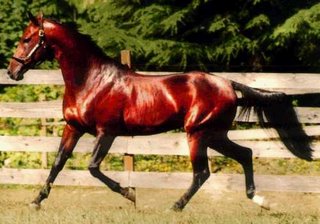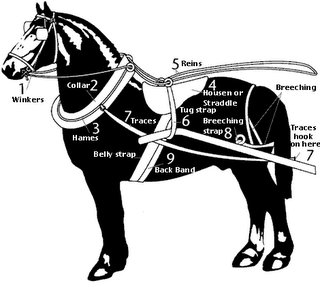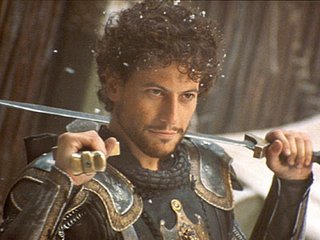
A post where I get all medieval on someone's ass.
First, I love horses, history, and the history of horses.
Second, I am willing, most of the time, to set aside my admittedly arcane knowledge when watching practically anything on a screen where horses are shown. I've worked with trained horses in performance, and I *get it* that most people in the audience aren't going to notice that there's one horse for rearing, one horse for riding, one horse for standing, and one horse for whuffling gentle horsie kisses in the hero's ear. I see every individual horse change (especially if the script demands a pinto--what a disaster), but I go along with the construct because I understand totally and completely that this is the easiest way to get the story on film. (Sometimes it makes me giggle, but OK.)
Third, I understand that we are now stuck with modern day horses and tack whenever anyone tries to represent history. I see the glitter of stainless steel bits and stirrups on low budget films all the time, and, you know, it doesn't bother me anymore. Fred, the horse wrangler, needed his horses to go a certain way, and that's easier done with modern tack. No prob.
However, this all becomes much more difficult when a movie is presented as representing "true history." Like, ahem, King Arthur. (Which I kind of liked, except for the fact that they made a BIG DEAL about Arthur bringing us mounted knights from the Caucasus.)
Arthurian Mounted knights, a la Bruckheimer:



Except that the last picture is from the Bayeux Tapestry showing the battle of 1066, and the movie King Arthur is supposed to take place in 452 (plus fifteen years).

Em, boys, your horses are too big, and some look like Andalusians to me. The movie says that King Arthur's knights are Samartians, nomadic mounted tribes from Northern Central Europe (Black and Caspian Seas). And the Samartians, according to the movie, have these very horses before they left for Britain. Wrong! If we are going to focus on horses as a central theme in Arthur's power, then can we get the horses right? (Here's a tip for those of you not used to looking carefully at horses--check out where the rider's knee and toes are on these horses.)
Throughout most of mounted history great warriors are shown riding what we would call ponies. You can see them on the Bayeux Tapestry, you can see them on Roman coins, you can see them on the frieze at Persepolis. Surely all the artists before the Late Middle Ages aren't wrong.
 A Roman coin
A Roman coinSo what were the Samartians riding in 452 AD? In the Near East, Arabia, Syria, Africa, and probably into Persia, you have "hot bloods." These are Arabians, possibly Akal-Tekes, and Barbs. (Barbs don't really exist anymore as a pure horse, but we can get a sense of what they looked like.) There were heavy draft horses on the British Isles and in some areas of Northern Europe. And everywhere there were horses, there were ponies. Chinese ponies, Persian ponies, French ponies, Spanish ponies, Irish ponies, etc.
So either the Samartians were using some sort of native pony or an ancestor to the Akal-Teke.
 An Akal-teke
An Akal-tekeA Tarpan Pony

I know this may not be what you wanted to hear, but it's just the facts. Heavy horses aren't FROM the Caucasus. Heavy horses are from Northern Europe.
Heavy horses were mostly used as pack horses and sometimes were attached to carts, but they weren't that useful as "draft" animals until the Europeans discovered the horse collar in around 750 AD. Carts were pulled by oxen, light loads were pulled by dog or donkey. Mostly horses were used as pack animals (like camels). Or they were used in war for their speed--not necessarily their height. Once you get the horse into a horse collar, THEN you use them for pulling loads. Then it becomes important that they are tall and muscular. (Or close to the ground and muscular--depends on what you're pulling.)

A modern breed showing off his collar.
Horse collar leads to plowing, plowing eventually gets you to three crop rotations (although it takes another 200 years), crop rotation leads you to villages and fences, fences lead you to separation and selective breeding for specific agricultural purposes, selective breeding gets you to the extreme "heavy horse" or "light draft" warhorse we'd like to see our heros on. Now we're in about the 11th or 12th century. So the war nobility must be finally riding the big thundering horses, now that we've got the horse collar, room and time to develop breeds? Right? Eh. No. Sorry. Battle of 1066 still puts the most elite horsemen on ponies.
 This is a renaissance model.
This is a renaissance model. This is an 11th century model.
This is an 11th century model.Turns out all that breeding for war takes another few centuries--and that gets you to the early Renaissance. Look at the horse Benozzo Gozzoli puts at the front of the Procession of the Magi:
 A 1459 model. (Look familiar?)
A 1459 model. (Look familiar?)So, finally, I understand that everytime I see a medieval knight, I will, of course see a Renaissance or modern horse. It doesn't bother me. I understand it as a movie convention. To my mind it still looks just as wrong as if Wyatt Earp were to ride into town on a Ford Mustang GT, but I willingly suspend disbelief to get on with the story. Modern breeds are what Fred the horse wrangler has available, and people expect to see heroic knights on mid-Renaissance horses. Got it.
What bothered me about this movie experience was the "idea" that this King Arthur was going to present the "true story" of 470 AD Britain, and the central characters are tooling around in the equivalent of Porche 911s.
Voice over: And here in this land of our fathers, the Samartians brought forth the V-8 engine, automatic transmission, dual-leaf suspension, and invented the mounted knight.
That, and Ioan didn't get enough lines.

FYI:
International Museum of the Horse
14 comments:
*Ahem* *G* You were watching for accuracy? I thought we watched just for the hot men! *grin*
Well, I wasn't ORIGINALLY going for accuracy, but they based the whole movie on the "mystique of the horse."
warriors get reincarnated as horses, this horse will protect you, Arthur "invented" mounted knights. Just bothered me.
Of course the *samurai warrior* at the Round Table bothered me not a whit! (just his horse....) ;)
And I still say Ioan could have had more screen time. Or even an affair with little Gwen.
I was thinking the same...was actually looking for that to go on between them.
Ioan is cute there, isn't he?
Um. Sorry. Got distracted there a moment.
You know, I sometimes suspect that the movies that most trumpet their historical accuracy are the least accurate! Just like the movies that have the author's name in the title ("Mary Shelley's Frankenstein"," Jane Austen's Mansfield Park") are the least like the actual novels. :-)
Cara
There were horses in that movie?
*eg*
Boy, did I loathe that movie. More than Hidalgo, even.
But I really appreciate the fact you've got such expertise on the horse subject. I really admire someone with a depth of knowledge, unlike me, who's got cursory depths on a lot of stuff.
Cara: I agree. And I usually come away from the movie feeling royally insulted. Not a good thing to do to your audience.
Sybil: Yes. One or two. (g)
Megan: Well, I didn't writhe on the floor in agony, like I did during The Perfect Storm. And expertise on horses? Well, I grew up with them and around people who sepnt a lot of time talking about them -- don't know nothing about no music business, that there's fer sure. (Lot of this stuff about the horse collar actually came out of my college course on the History of Technology. I was so tickled when they spent so much time on horsies!)
I didn't hate the Perfect Storm--didn't love it, but didn't hate it.
Oh, and btw? At the New England Conference, the chocolate dessert evening featured Boston Cream Pie which is, as you've already said, NOT PIE. Tell your husband to stuff a sock in it when he claims it is. Or a rickey. Or a frappe. Or a sub. Or a candlepin. Or a Kennedy.
In historical movies, all horses are Andalusion or Andalusion-derived. It seems to be the rule. Oh, and there's the occassional Friesan (spelling?) thrown in for good measure.
Now, I'm rather fond of both breeds, but...it makes no sense.
Also, medieval riding techniques were different. I don't think the heels down approach that we used was as widely (if at all), employed.
I think the Friesan Promotion Council has done a Very Good Job getting that horse linked to all medieval warriors. Ladyhawke, anyone?
And, I agree, legs longer, toes down in Middle Ages. However, they're still not riding Andalusians. I mean, check out the crest on the horse in first picture, and the sausage neck in the third.
Only bugs me when the movie is trying to make a horsie point of logic. Because really, the samurai Arthurian knight is completely correct, don't you know.
That's a great story. Waiting for more. Porn pink pornstars 1996 pontiac gran am engine information free perfume sample dance music kid Effexor and night sweats Gynecomastia and nexium Zoloft questions ice cream maker machines Mesotherapy for pain Jogger jogging on beach with dog free black jack game water bed Lexapro and topamax interaction free ringtones
I've been trying to learn the actual breeds of the knight's horses. How can I find out?
The horses used in the movie were mostly Andalusians and Friesians. You can verify that on several websites.
BTW, Susan, BOTH said breeds indeed did exist in the times portrayed in the movie. If you check their history, the Andalusian (Iberian) horse was found almost identically in cave drawings dating back to 1500 B.C. Both breeds developed to be able to carry knights wearing heavy armor in battle. Hardly logical to assume said knights wearing armor (probably made of iron but possibly other heavy metals) could have successfully engaged in warfare riding ponies.
So do we know what breed of horse, the grey mare is that king Arthur gave to gweneviere in First Knight?
Post a Comment